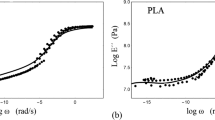Abstract
Rheology in the highly viscous liquid and the glassy state is reviewed and discussed. A distribution relaxation time due to the co-operative molecular motion is exhibited both in the highly viscous liquid and in the glassy states. However, only in the glassy state has the structure been frozen-in at some particular internal state resulting from the incomplete establishment of a thermodynamic equilibrium state. Therefore, the intrinsic non-linear rheological behaviour of the glassy state is explained from the physical and thermodynamic aspects in the glass transformation region. The volume relaxation of soda-lime-silica glass and the thermal history of glass during forming process have been studied. Finally, the role of rheology in thermal stress and fracture mechanics is also mentioned, which subsequently will allow us to re-evaluate the mechanisms of toughening and weakening of composite materials.
Similar content being viewed by others
References
G. Tammann, Der Glaszustand (Leipzig: Voss), (1933) 18.
R. O. Davies and G. O. Jones, Adv. Phys. 2 (1953) 370.
W. Kauzmann, Rev. Mod. Phys. 14 (1942) 12.
Idem, Chem. Rev. 43 (1948) 219.
P. Ehrenest, Proc. K. Akad. Wetensch 36 (1933) 153.
F. E. Simon, Z. Anorg. Chem. 203 (1931) 219.
T. A. Litovitz and C. M. Davis, “Physical Acoustics”, edited by W. P. Manson, Vol. IIA (Academic Press, New York, 1965) Ch. 5.
P. Macedo and T. A. Litovitz, Phys. Chem. Glass 6 (1965) 369.
J. Tauke, T. A. Litovitz and P. B. Macedo, J. Amer. Ceram. Soc. 51 (3) (1968) 159.
T. A. Litovitz and P. Macedo, “Physics of Non-Crystalline Solids” (North Holland, Amsterdam, 1964) p. 220.
P. B. Macedo, J. H. Simmons and W. Haller, Phys. Chem. Glass 9 (5) (1968) 156.
I. Prigogine and R. Defay, “Chemical Thermodynamics”, Translated by D. H. Everett (Wiley, New York, 1962) Ch. XIX.
H. S. -Y. Hsich, J. Amer. Ceram. Soc. 60 (1977) 485.
Idem, J. Mater. Sci. 13 (1978) 750.
G. E. McDuffie and T. A. Litovitz, J. Chem. Phys. 37 (1962) 1699.
M. Prod'homme, Rev. Int. Haut. Temp Refract. 12 (1975) 79.
J. DeBast and P. Gilard, Phys. Chem. Glasses 4 (4) (1963) 117.
B. Gross, “Mathematical structure of the Theory of the Viscoelasticity” (Hermann, Paris, 1953).
S. Spinner and A. Napolitano, J. Res. Nat. Bur. Stand. 70A (1966) 147.
R. D. Corsaro, Phys. Chem. Glasses 17 (1976) 13.
L. Boesch, A. Napolitano and P. B. Macedo, J. Amer. Ceram. Soc. 53 (1970) 148.
G. Goldbach and G. Rehage, Rheo. Acta 6 (1967) 30.
Idem, J. Polymer Sci. C 6 (1967) 2289.
G. Rehage and G. Goldbach, Bunsenges 70 (1966) 1144.
O. S. Narayanaswamy and R. Gardon, J. Amer. Ceram. Soc. 52 (1969) 554.
Yr. G. Korabel'nikov, Polymer Mechanics, Translated from Russian Original, 7 (4) July–August (1971) 589, Dec. 1973.
S. P. Timoshenko and J. N. Goodier, “Theory of Elasticity”, 3rd edn. (McGraw-Hill, New York, 1970) p. 433.
R. Gardon and O. W. Narayanaswamy, J. Amer. Ceram. Soc. 53 (1970) 380.
E. H. Lee, T. G. Rogers and T. C. Woo, ibid. 48 (1965) 480.
F. F. Lange, “Composite Materials”, edited by L. J. Broutman, Vol. 5 (Academic Press, New York, 1974) p. 1.
Idem, “Fracture Mechanics of Ceramics”, edited by R. C. Brandt, D. P. H. Hasselman and F. F. Lange, Vol. 4 (Plenum, New York, 1978) pp. 799–819.
J. Selsin, J. Amer. Ceram. Soc. 44 (1961) 419.
W. D. Kingery, ibid. 40 (1957) 351.
M. A. Stett and R. M. Fulrath, ibid. 53 (1970) 5.
A. G. Evans, J. Mater. Sci. 9 (1974) 1145.
R. W. Davidge and T. J. Green, ibid. 3 (1968) 629.
R. J. Young and P. W. Beaumont, ibid. 12 (1977) 684.
A. Pavan and T. Ricco, ibid. 11 (1976) 1180.
D. B. Binns, “Science of Ceramics”, Vol. I, edited by G. H. Stewart (Academic Press, New York, 1962) p. 325.
Author information
Authors and Affiliations
Rights and permissions
About this article
Cite this article
Hsich, H.S.Y. Physical and thermodynamic aspects of the glassy state, and intrinsic non-linear behaviour of creep and stress relaxation. J Mater Sci 15, 1194–1206 (1980). https://doi.org/10.1007/BF00551809
Received:
Accepted:
Issue Date:
DOI: https://doi.org/10.1007/BF00551809




